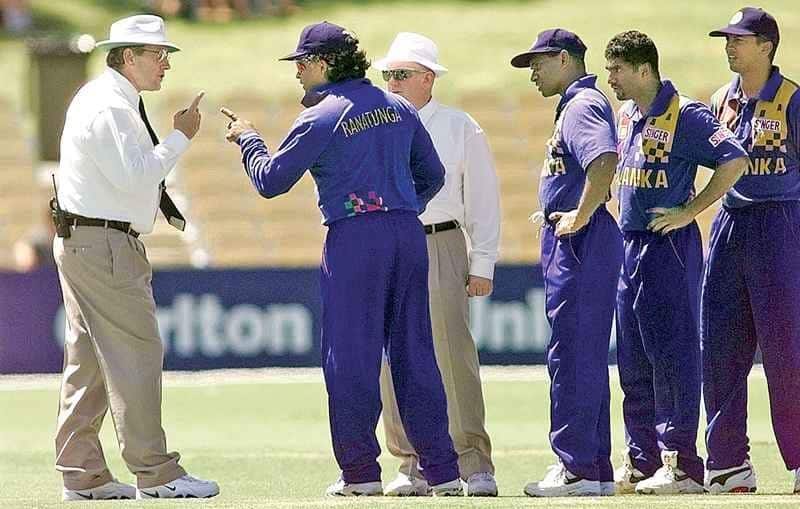The Rise of Muralitharan
Muralitharan’s bowling action has a long story to spin around but his cricketing journey began like any other cricketer’s, but his unique talent soon set him apart. With a prolific ability to spin the ball, he quickly rose through the ranks to become one of the most celebrated spin bowlers in the world. With an unorthodox bowling action and a bag full of tricks, Muralitharan had become a formidable force in world cricket during the 1990s.
Unconventional Muralitharan's Bowling Action
Muralitharan’s bowling action was anything but conventional. His wrist-twisting, high-arm action puzzled not only batsmen but also cricket purists. Critics were quick to label it as illegal, raising questions about the fairness of his deliveries
Controversy Strikes Down Under
The year 1996 marked a pivotal moment in Muralitharan’s career. During a tour of Australia, the controversy over his bowling action came to the forefront. The Australian crowds, media, and even players were vocal in their skepticism, creating a hostile environment for the young spinner. The pivotal moment of controversy occurred during the first Test match of Sri Lanka’s tour of Australia in 1995. On the second day of the Boxing Day Test at the Melbourne Cricket Ground (MCG), Muralitharan was repeatedly no-balled for throwing (illegally straightening his bowling arm during the delivery stride) by the Australian umpire, Darrell Hair. The issue of throwing was not new to Muralitharan, as he had faced similar allegations in the past. However, it was the number of no-balls called during this match that intensified the controversy. The contentious decision by Darrell Hair triggered a heated debate among players, experts, and cricket fans worldwide.

Scientific Analysis of Muralitharan's bowling action
Supporters of Muralitharan argued that his bowling action was unique, as it involved a “flexible” wrist that allowed him to generate extra spin and bounce. They believed that Muralitharan’s action was within the legal limits defined by the International Cricket Council (ICC). Furthermore, many believed that the no-ball calls were unjustified, and the umpire’s decision was influenced by biased home-ground advantage.
On the other side, critics of Muralitharan’s action contended that it violated the rules of cricket. They claimed that his action exceeded the allowed 15 degrees of elbow extension, which was deemed acceptable for bowlers by the ICC. The critics cited the results of scientific tests on Muralitharan’s bowling action, which reportedly showed excessive straightening of his arm during the delivery.
Reactions and Impact
The controversy escalated further as the Sri Lankan team rallied behind their champion spinner, accusing the Australian team and umpires of unfair targeting. They questioned the timing and scale of the no-ball calls, which seemed excessive and prejudiced against Muralitharan.
The incident led to a strained relationship between the cricketing boards of Australia and Sri Lanka. It also brought the issue of chucking (illegal bowling action) to the forefront of cricketing discussions. The ICC was compelled to review its guidelines on bowling actions and set up a more stringent process for testing suspect actions.

The Truth about Muralitharan's Bowling Action
Through meticulous analysis, it was revealed that Muralitharan’s unique action was a result of a congenital condition, wherein his arm hyperextends, allowing him to achieve a greater degree of spin. This groundbreaking revelation shattered the myth that he was cheating.
Legacy and Recognition
Despite the adversity, Muralitharan went on to achieve incredible success in the cricketing world. He became the highest wicket-taker in both Test and One-Day International (ODI) cricket, earning the respect and admiration of fans worldwide.
Frequently Asked Questions
1.Was Muralitharan’s bowling action illegal?
No, it was not. Scientific analysis revealed that his unique action was due to a congenital condition, not an attempt to cheat.
2.Did the controversy affect Muralitharan’s career?
Initially, it did create challenges, but he went on to become one of the most successful bowlers in cricket history.
3.How did the ICC resolve the controversy?
The ICC, after thorough analysis, cleared Muralitharan’s action and allowed him to continue playing.
4.What is Muralitharan’s legacy in cricket?
He is one of the greatest spin bowlers in the history of cricket, holding numerous records for wickets in Test and ODI cricket.
5.What lessons can be learned from Muralitharan’s story?
Muralitharan’s story teaches us the importance of scientific analysis, the resilience of true talent, and the need to support and nurture unique skills in sports.
Conclusion
In conclusion, the Muralitharan’s Bowling Action Controversy of 1996 was a pivotal moment in cricket history. It brought to light the complexities of bowling actions, the challenges faced by unconventional talents, and the power of scientific analysis in dispelling myths. Muralitharan’s legacy as one of the greatest spin bowlers remains untarnished, and his unique action is now celebrated as an embodiment of cricket’s diversity.

Pingback: Leg Spinner Vs Off Spinner Who is the Champion of Cricket?